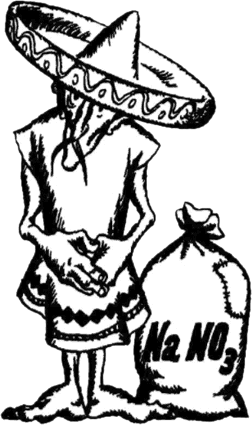107Stories About ChemistryINDEX |
103.
The �Nitrogen Crisis�
About one hundred years after the discovery of nitrogen a prominent microbiologist wrote: �Nitrogen is more valuable from the point of view of general biology than the rarest of the noble metals.� And he was quite right. Nitrogen is a constituent of practically all protein molecules, whether of plant or animal origin. Without nitrogen there is no protein, and without protein there is no life. Engels said that �life is the form of existence of proteins.� To produce protein molecules plants need nitrogen. But where do they get it? The chemical activity of nitrogen is low and it does not enter into reactions under ordinary conditions. Hence, plants cannot use atmospheric nitrogen. Truly, �there�s many a slip �twixt cup and lip.� Therefore, the plant�s entire store of nitrogen is in the soil. Alas, this store is meagre. It holds few compounds containing nitrogen. That is why the soil loses its nitrogen rapidly and requires the addition of nitrogenous fertilizers. The name �Chile saltpetre� has now become a thing of history. But about seventy years or so ago it was talked about everywhere.  The vast territory of the Republic of Chile includes the dismal Atacama desert which stretches over hundreds of kilometres. At first glance it is just an ordinary desert, but there is a curious thing that distinguishes it from all the other deserts of the globe: a comparatively thin layer of sand overlies thick deposits of sodium nitrate known also as sodium saltpetre. These deposits were known a long time ago, but the first time they were thought of seriously was probably when a deficiency of gunpowder began to be felt in Europe. It must be remembered that previously gunpowder was made of charcoal, sulphur and saltpetre. An expedition was sent out at short notice to fetch this overseas product. However, the entire cargo had to be thrown out into the sea. It proved that only potassium saltpetre could be used for the production of gunpowder. Sodium saltpetre absorbed moisture avidly from the atmosphere, making the gunpowder damp and useless. That was not the first time Europeans had had to throw overseas cargoes overboard. In the seventeenth century grains of a white metal subsequently called platinum were found on the banks of the River Platino-del-Pinto. When platinum was first brought to Europe in 1735 nobody knew what to do with it. Of the noble metals only gold and silver were known at that time, and platinum had no outlet. But some clever people noticed that the densities of platinum and gold were rather close, and making use of this fact they began to add platinum to the gold used for making coins. Now this was forgery. The Spanish government forbade any further import of platinum, and as to the reserves already accumulated in the country, they were collected and thrown out into the sea in the presence of numerous witnesses. But the history of Chile saltpetre was not ended. It was found to be an excellent nitrogenous fertilizer which nature kindly placed at man�s disposal. At that time no other nitrogenous fertilizers were known. Intensive mining operations were started at the Chilean deposits and ships loaded with the valuable fertilizer left the port of Iqueque daily to deliver it to all parts of the globe. ... In 1898 Sir William Crookes�s sombre prediction struck the world with awe. In one of his speeches he prognosticated death to mankind from nitrogen starvation. The fields are annually being deprived of nitrogen together with the crops, said he, and the deposits of Chile saltpetre are gradually nearing exhaustion. The treasure house of the Atacama desert was but a drop in the ocean. It was then that scientists thought of the atmosphere. Probably the first man to draw attention to the unlimited supply of nitrogen in the atmosphere was the famous Russian scientist Timiryazev, who believed firmly in science and in the power of human genius. He did not share Crookes�s misgivings. He was certain that mankind would overcome the nitrogen crisis and would find some way out of the situation. And he was right. Not later than in 1903 two Norwegians, the scientist Kristian Birkeland and the engineer Samuel Eyde accomplished the fixation of atmospheric nitrogen on an industrial scale by means of an electric arc. At about the same time the German chemist Fritz Haber developed a process for the production of ammonia from nitrogen and hydrogen. This finally solved the problem of combined nitrogen so necessary for plant nourishment. There is plenty of free nitrogen in the atmosphere. Scientists have calculated that if all the nitrogen in the atmosphere were transformed into fertilizers there would be enough to nourish all the plants in the world for more than a million years. |





